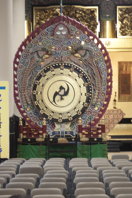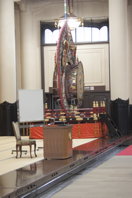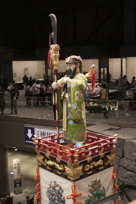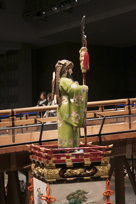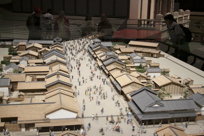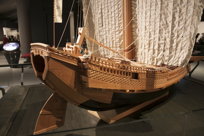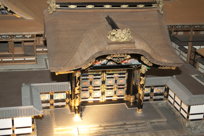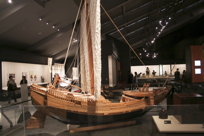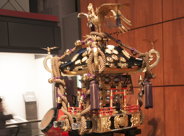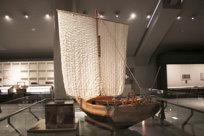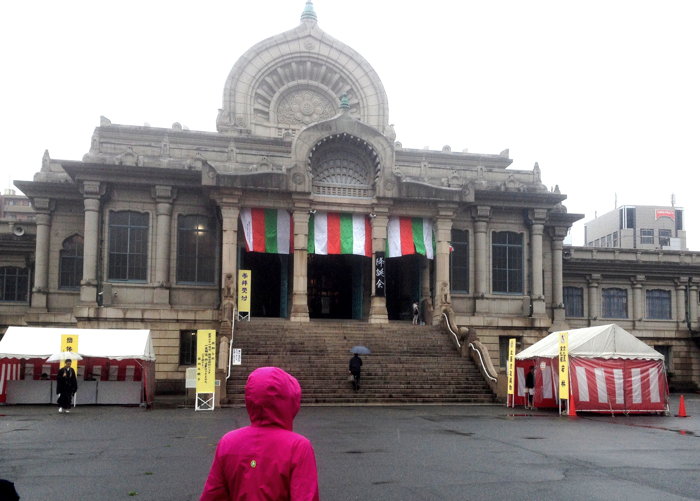
|
| The Tsukiji Honganji in the rain. An iPhone picture, not the best quality. That’s Cindy in the foreground. |
Wednesday, 21 May: a rainy day
without many pictures
After a delicious Japanese breakfast, we went out seeing the sights. It was fairly rainy this morning, and at our first stop, the Tsukiji Honganji, I never pulled my camera out outdoors. It’s a Buddhist temple with a most unusual architecture, obviously modeled on Indian originals. What you see above was built only in the 1930’s, to replace a temple leveled by the disastrous Kanto earthquake of 1923.
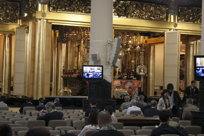
I’m always a bit reticent about entering a house of worship in a foreign country, especially when there’s some obvious religious action going on. But we went inside, even though there was a sermon being delivered in what sounded to me like a perfect monotone. You can see the television monitors in the picture to the right, and the wonderful ornateness of the decoration. Not exactly a New England meeting-house!
A notable feature of the Honganji was the big drum up front. The two images to the left show it: the first view is straight on, the second is a side view. Notice that the drum itself is suspended in an essentially two-dimensional frame, and that the two mythical birds on this just above the drum look at first glance like eyes. Perhaps this is most clearly seen in the smaller view.
The rain got heavier, and I kept my camera in my pack for quite a while. We’ll have to depend on my journal:
«That was at Tsukiji, the neighborhood where there’s a huge market of fish and other stuff. We walked around the market in the rain, which at times was rather heavy, and we admired. Mike and Mason stopped for a mixed shellfish sampler cooked and seared on a scallop shell.
floats, life-size copy
«We found a counter joint for lunch, which had a conveyor belt carrying dishes of sushi. You just pulled down whatever dish you wanted, and the price was determined by the kind of dish your choice was on. I pulled down a total of six dishes, Mark took seven or eight nine, including a mango jello.
«From there we took subway and JR to the Edo-Tōkyō Museum. That was heavy on scale models of sections of the city in the Edo period (before the end of the Shogunate in 1855-60) and of the Shogun’s palace. Lots of restorations of ceremonial objects, like a float that would be brought out for only one festival per year.»
In the block of pictures to the right, all from the museum, in the left-hand column you see a diorama or model in tiny-size of a neighborhood in Edo, which was the name of Tokyo up till 1868 (big image, small). Below that, a model of a gate, I think it was in the Shogun’s palace (big image, small). And last in that column, an amazing thing, described in the placard that you see below it in the big or small images, as follows: “Mikoshi (portable shrine) of the kind used in the Edo Sanja Festival”. I was fascinated by this, and I’m sorry that no photograph can make its complexity transparent. So much detail, so much ornateness, so very unlike anything we’re used to.
In the right-hand column, three views of a sailing vessel, I imagine it was half-sized, or so, and really interesting. Top image: big, small; middle: big, small; and bottom: big, small.
For the rest of the day, we’ll have to depend on my journal. I wrote:
«The Moorman-Kings had arranged for tickets to a sumo match, but Mark and I weren’t interested. So they three went to the sumo stadium, in the same neighborhood [as the museum], while Mark and I walked a mile or so along the [Sumida] river bank to Asakusa. We stopped for a beer at the same bar [as the one where we had had a drink on our first night], then went for a nap, sleeping about three hours, before the others returned. We had a light supper around the corner from the ryokan, and were to bed around ten.»
